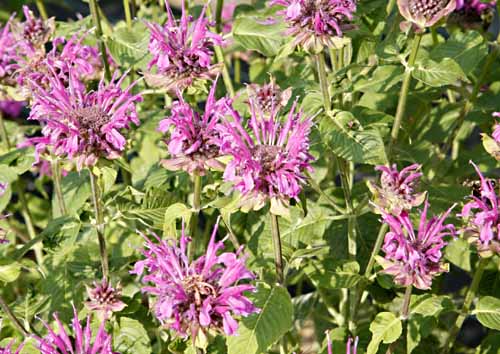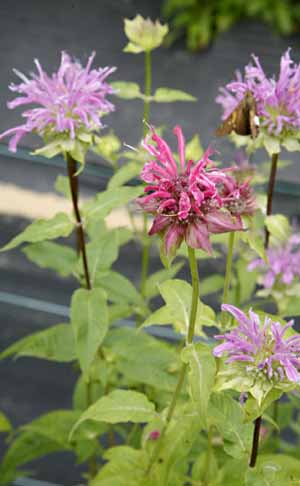A bright cheerful tough native perennial that is easy to care for and needs little maintenance established. Growing to 4 feet in height it is crowned by masses of blossoms in mid summer. Likes full sun to partial shade with a moist soil. Deer and rabbits don't eat it because of its spicy mint like foliage which makes an excellent tea and gives Earl gray tea its flavor. Will spread quite quickly once established and produce masses of flowers for many years. Ideal for many garden settings, good in meadows, borders or individual plantings.
Description
Bee balm is a hardy (to zone 4) spreading perennial. It sends up its first shoots
in early spring which quickly grow to anywhere between 2 and 5 feet in height.
The leaves are elliptic from 2-6" in length and 1-3" wide with serrated
or toothed margins. They are arranged in opposite pairs along the square stems
and are mid to darker green in color. The foliage is quite aromatic with a minty
peppery citrus aroma. The square stems are commonly unbranched but often branch
near the top to produce more flowers. The flowers are located at the top of
the stems which bear only one flower cluster per stem. The flowers are about
1 ½" long and tubular terminating in two lips with long protruding
stamens. Each flower cluster is arranged in whorl and bears many flowers of
which only a few flower at a time which increases the flowering time of the
plant. Flowers tend to bloom from the outside towards the center. The flowers
can be light pink, dark pink, burgundy, scarlet, white or lavender. Beneath
the flower cluster is a whorl of reddish bracts, some are leafy others more
bristly which enhance the color of the flowers.
Location and care
Will grow in any soil type but needs it to be slightly moist at all time for
the best results. Adding a lot of organic material will enhance the plant growth
and allow more moisture to be retained in the soil. This is especially useful
in sandy or sandy loam soils. Does well in clay soils but still likes good rich
organic material.
Does well in full sun if the soil is always slightly moist, if the soil dries
out on a regular basis grow in part shade to compensate. Using a soaker hose
around the base of the plants is the best ways to keep them watered.
Bee Balm is very susceptible to powdery mildew especially as the season progresses.
To help control this water from the ground, not from an overhead sprinkler (hence
the soaker hose) and plant in a location where there is good circulation through
the plant. Do not plant against a wall, fence or tree line.
Plants have a clumping nature and spread by means of surface or shallow roots.
To contain the plants they can be planted in pots which are sunk in the ground
leaving 2-3" above the surface or by using a plastic or metal 'collar'
plastic garden edging rolls are ideal. Place the edging around the plant sunk
about 2-3" into the ground and protruding the same amount above. Plants
grow from the center outwards and after 3-4 years the centers become less vigorous
and attractive. To revitalize dig up plants and remove centers and replant the
outer sections. Best done in early spring.
Bumblebees, butterflies, and hummingbirds love the tubular flowers, although
honey bees are unable to reach the nectar.
Growing
Seeds can be sown indoors or directly sown in the garden.
Outdoors. Plant seeds at least one week after the last frost date. Prepare
the bed well and sow seeds thinly. Barely cover the seed and water well with
fine spray from hose daily unless there is rain. Soil must be kept moist. Once
plants have germinated thin to at least 14" apart. Continue to water until
plants are at least 6" tall. If in dryer area install soaker hoses or ground
irrigation to
continue watering. If in naturally moist soil area no further
care is needed.
Indoors. Start seeds in late winter in flats or plug cell trays (recommended).
Germination usually occurs in about 10-40 days depending on temperature and
other conditions. Keep soil moist at all times. See our general
growing instructions for more details. When plants are large enough to handle
transplant to individual pots. Harden plants off outside in shade before transplanting
into garden after all danger of frost has passed.
Does not always flower in the first year from seed.
Problems.
Monarda can be susceptible to powdery mildew, which is exacerbated by humidity
and any kind of plant stress (even drought). To reduce the tendency for disease,
keep the soil moist, minimizing overhead watering, and space plants far enough
apart to allow for good air circulation between plants.
Mulch plants with either pine needles or wood chips as this allows more air
circulation at ground level than other materials. Cut back affected plants after
blooming to about 3" from ground. Plants will regenerate and sometimes
flower a second time. Discard infected leaves, do not use in compost. They can
be burnt or removed with garbage.
Sometimes the plants can be attacked by aphids, however since the flowers attract
so many other beneficial insects these usually also take care of the aphids
fairly quickly so no spraying in needed.
Collecting and Harvesting.
Fresh leaves can be picked at any time, ideally in late morning after the dew
has evaporated. Ensure leaves have no mildew.
For drying collect leaves in mid to late spring before any chance of mildew
can occur. Flowers can be collected as they bloom. Spread leaves out on wire
racks in a warm dry location, or use a dehydrator. Leaves and flowers should
be dried rapidly to retain the color and flavor.
Flower stalks can be picked when in full bloom and hung to dry in bunches for
later use in dried flower arrangements.
Edible Uses
Leaves and young shoot tips - raw or cooked. They are used as a flavouring in
salads, fruit salads and drinks. The flowers make an attractive and delicious
garnish to salads. Leaves can be used as a substitute for sage in stuffing for
poultry and meats, especially pork and veal Both the leaves and flowers make
an excellent tea and was used as a substitute for such after the Boston Tea
Party. The leaves are now used to give the characteristic Earl Gray flavour
to China tea.
Medicinal Uses
Was originally used by Native Americans to treat many disorders and as such
a useful plant was quickly adopted by pioneer herbalists. Today it is used to
treat digestive disorders. Infusions (teas) are used for flatulent colic, nausea,
vomiting upset stomach and sickness. It is also used as a diuretic to treat
urinary disorders, and to combat fever and heart disease. The oil extracted
from the leaves is used to treat rheumatism.
Other Uses
Yields an essential oil, used in perfumery, as a hair tonic. The dried leaves
and flowers are used in flower arrangements and to scent and add colour to pot-pourri.
Other names.
American Bee Balm, American Melissa, Fragrant Balm, Gold Melissa, Horse Mint,
Indian Nettle, Indian Plume, Oswego Tea, Red Balm, Red Bergamot, Scarlet Bergamot,
Scarlet Monarda








